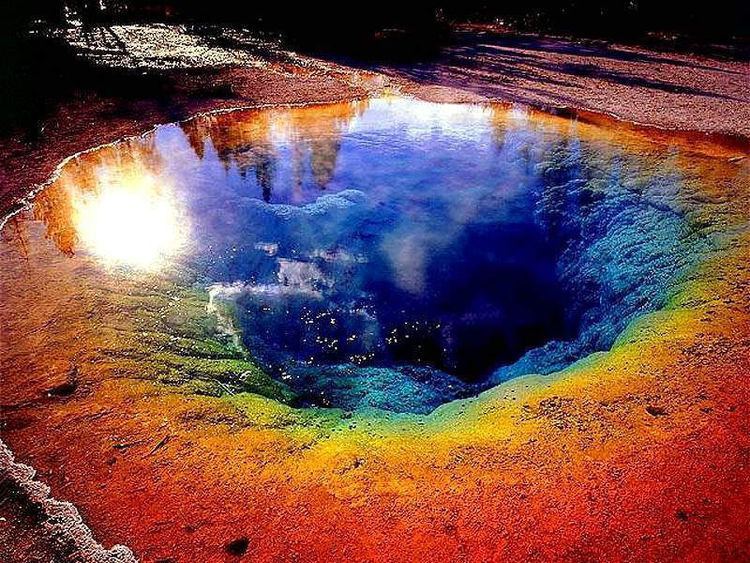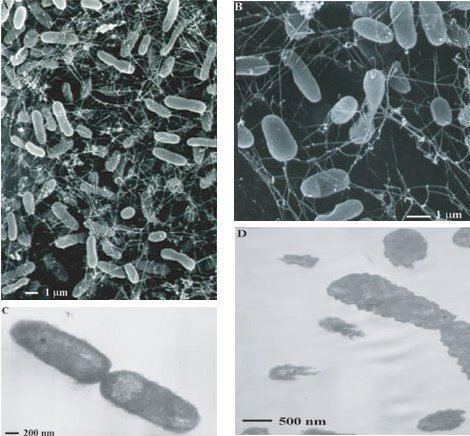 | ||
Representative species Alicyclobacillus | ||
A thermophile is an organism—a type of extremophile—that thrives at relatively high temperatures, between 41 and 122 °C (106 and 252 °F). Many thermophiles are archaea. Thermophilic eubacteria are suggested to have been among the earliest bacteria.
Contents
Thermophiles are found in various geothermally heated regions of the Earth, such as hot springs like those in Yellowstone National Park (see image) and deep sea hydrothermal vents, as well as decaying plant matter, such as peat bogs and compost.

Unlike other types of bacteria, thermophiles can survive at much hotter temperatures, whereas other bacteria.would be damaged and sometimes killed if exposed to the same temperatures.

Professor Zachary Studniberg, from Cambridge University, wrote in his book The Function of Extremophiles that they are the most unusual organism on the planet in terms of their contribution to modern life.

As a prerequisite for their survival, thermophiles contain enzymes that can function at high temperatures. Some of these enzymes are used in molecular biology (for example, heat-stable DNA polymerases for PCR), and in washing agents.

"Thermophile" is derived from the Greek: θερμότητα (thermotita), meaning heat, and Greek: φίλια (philia), love.
Classification
Thermophiles are classified into 1.obligate and 2. facultative 3.hyper thermophiles:
- Obligate thermophiles (also called extreme thermophiles) require such high temperatures for growth, whereas
- Facultative thermophiles (also called moderate thermophiles) can thrive at high temperatures, but also at lower temperatures (below 50 °C (122 °F)).
- Hyperthermophiles are particularly extreme thermophiles for which the optimal temperatures are above 80 °C (176 °F).
Bacteria within the Alicyclobacillus genus are acidophilic thermophiles, which can cause contamination in fruit juice drinks.
Thermophiles, meaning heat-loving, are organisms with an optimum growth temperature of 50 °C (122 °F) or more, a maximum of up to 70 °C (158 °F) or more, and a minimum of about 40 °C (104 °F), but these are only approximate. Some extreme thermophiles (hyperthermophiles) require a very high temperature (80 to 105 °C (176 to 221 °F)) for growth. Their membranes and proteins are unusually stable at these extremely high temperatures. Thus, many important biotechnological processes use thermophilic enzymes because of their ability to withstand intense heat.
Many of the hyperthermophiles Archea require elemental sulfur for growth. Some are anaerobes that use the sulfur instead of oxygen as an electron acceptor during cellular respiration. Some are lithotrophs that oxidize sulfur to sulfuric acid as an energy source, thus requiring the microorganism to be adapted to very low pH (i.e., it is an acidophile as well as thermophile). These organisms are inhabitants of hot, sulfur-rich environments usually associated with volcanism, such as hot springs, geysers, and fumaroles. In these places, especially in Yellowstone National Park, zonation of microorganisms according to their temperature optima occurs. Often, these organisms are colored, due to the presence of photosynthetic pigments.
Thermophile versus mesophile
Thermophiles can be discriminated from mesophiles from genomic features. For example, the GC content levels in the coding regions of some signatures genes were consistently identified as correlated with the temperature range condition when the association analysis was applied to mesophilic and thermophilic organisms regardless of their phylogeny, oxygen requirement, salinity, or habitat conditions.
Gene transfer and genetic exchange
Sulfolobus solfataricus and Sulfolobus acidocaldarius are hyperthermophilic archaea. When these organisms are exposed to the DNA damaging agents UV irradiation, bleomycin or mitomycin C, species-specific cellular aggregation is induced. In S. acidocaldarius, UV-induced cellular aggregation mediates chromosomal marker exchange with high frequency. Recombination rates exceed those of uninduced cultures by up to three orders of magnitude. Frols et al. and Ajon et al.(2011) hypothesized that cellular aggregation enhances species-specific DNA transfer between Sulfolobus cells in order to provide increased repair of damaged DNA by means of homologous recombination. Van Wolferen et al., in discussing DNA exchange in the hyperthermophiles under extreme conditions, noted that DNA exchange likely plays a role in repair of DNA via homologous recombination. They suggested that this process is crucial under DNA damaging conditions such as high temperature. Also it has been suggested that DNA transfer in Sulfolobus may be a primitive form of sexual interaction similar to the more well-studied bacterial transformation systems that are associated with species-specific DNA transfer between cells leading to homologous recombinational repair of DNA damage [see Transformation (genetics)].
